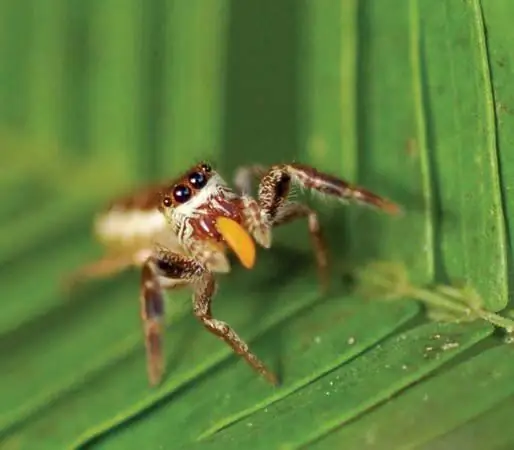- Author Henry Conors [email protected].
- Public 2024-02-12 02:48.
- Last modified 2025-01-23 09:07.
Butterflies, like flowers, cause sincere admiration for their beauty. Each country has its own ideas about the origin of these amazing creatures. In ancient Greece, they believed that the butterfly and the soul are one and the same. And now in modern Greek they have one name. As for Russia, here the word "butterfly" first began to be used in the 18th century. According to most scholars, it takes its name from the word "baba" - "married woman".

Currently, most species of butterflies are listed in the Red Book. The man is to blame for this, who, with his indefatigable activity, destroys their habitats. This article is dedicated to one of the most beautiful butterflies, which is endangered. This is an Apollo butterfly.
Origin of the name
Why the Apollo butterfly was named after the Greek god of light, the patron of the arts and the leader of the nine muses, now no one can say for sure. We can only build our assumptions on this score. Butterfly is very beautiful. Large, light in color, it is visible from afar. Prefers mountain plains. Maybe she is named after one of the gods because of her beauty and the fact that she likes to live closer to the sun.
Apollo butterfly: description and imagelife
Scientifically speaking, the Apollo is a diurnal butterfly of the sailfish family (Papilionidae). The full name is the Apollo sailboat (Parnassius apollo). The Apollo butterfly is incredibly beautiful - it has translucent wings of white or cream color, decorated with large rounded spots. On the front wings they are black. The rear ones have red spots with black edging. This is the largest butterfly in European Russia. Its wingspan can reach 9-10 centimeters.

Habitat - open and sun-warmed mountain plains, alpine meadows and slopes of Europe, Ukraine, the Urals, Siberia, the Caucasus, the Tien Shan, Kazakhstan and Mongolia. The period of appearance is from July to September. Butterfly Apollo prefers large flowers of oregano, ragwort, loves different types of clover. Apollo breeds almost immediately after leaving the pupae. The female lays up to 120 eggs, each separately on a host plant. Adult Apollo caterpillars are also very beautiful. Black in color, like velvet, decorated with two rows of red-orange spots, they look very impressive. The caterpillar feeds on juicy leaves of stonecrop, rabbit cabbage.

Apollo's pupal stage lasts 1-3 weeks. Then a new butterfly emerges from it.
Such a different Apollo
The insect is of great interest to naturalists because it has a huge number of species. To date, at least 600 varieties of Apollo are known.
Parnassius mnemosyne cloudedApollo, or Mnemosyne, is one of the most beautiful species. Snow-white wings, completely transparent at the edges, are decorated only with black spots. This makes the butterfly incredibly elegant. Its second name is black memosyne, since it is painted only in two colors - white and black.

Arctic Apollo Butterfly (Parnassius arcticus) is another beautiful species. It lives in the mountain tundra on the territory of Yakutia and the Khabarovsk Territory. She was also found in the Magadan region. The wings are white with small black spots. It is interesting that the Gorodkov Corydalis plant is a fodder plant for both butterflies and caterpillars of the Arctic Apollo. The biology of this species has been little studied due to its extreme rarity.
Apollo butterfly: interesting facts and details
The beauty of this insect was admired by many famous researchers and biologists who described it in the most poetic terms. Some compared the flight of Apollo with the poetry of movement, others called him a graceful inhabitant of the Alps.
In the evening the butterfly descends and hides in the grass at night. When in danger, it first tries to fly away, but does it very clumsily, because it does not fly well. Realizing that it is impossible to escape by flight, it spreads its wings and begins to rub against them with its paw, making hissing sounds. So she tries to intimidate her enemy. Despite the reputation of a butterfly that does not fly very well, in search of food, an insect can fly up to 5 kilometers in a day. Apollo arctic lives on the border of the territory where the snow never melts. A Parnassiushannyngtoni is the highest mountain butterfly living in the Himalayas, at an altitude of 6000 meters above sea level.
The threat of extinction of the most beautiful butterfly in Russia and Europe
By the middle of the 20th century, Apollo had completely disappeared in the Moscow, Smolensk, and Tambov regions. In almost all countries of its habitat, the butterfly is listed in the Red Book as an endangered species. There are many reasons for the disappearance of Apollo. First of all, this is the destruction of food zones by humans. Another reason is the narrow specialization of butterfly caterpillars. They can only eat stonecrop. In addition, they are very capricious and sensitive to the sun. They only eat when the sun is shining. As soon as he goes beyond the clouds - that's it, the caterpillars refuse to eat and descend from the plant to the ground.
The largest butterfly is very noticeable on the mountain slopes. In addition, as already mentioned, the Apollo does not fly well. He does this as if reluctantly, barely flapping his wings and often dropping down to rest. Therefore, it represents easy prey for humans.

Steps are now being made to restore the Apollo population, but so far they have not brought any significant results. In order for the butterfly to cease to be considered an endangered species, it is necessary to create special feeding zones and certain conditions for its existence.






